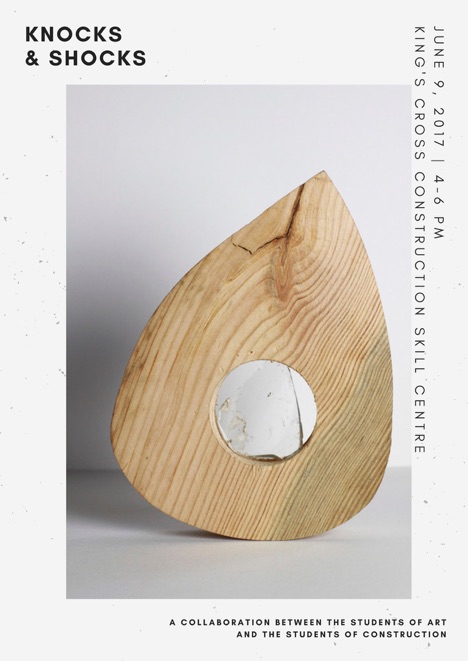Knocks & Shocks was a project developed for the second year BA students at Central Saint Martins College of Art and Design. I designed a process where the students of art worked in a close collaboration with the students of construction. The project culminated with the final event. Below is the press release from that event.
KNOCKS & SHOCKS
Molly Beard, Daniel Birch, Sam Chapman, Oguzcan Dogan, Kodie Harvey, Felicity Hazell, Rachel Hinman, Shana Johnson, Alankrita Khaitan, Mohammed Swayeb Khan, James Miller, Richard Nolan, Felippo Ntagasos, Eve Rusk, Chung Him (Roy) Wong
‘in-between spaces’ provide the terrain for elaborating strategies of self-hood – singular or communal – that initiate new signs of identity, and innovative sites of collaboration, and contestation, in an act of defining the society itself
(Bhabha, 1994)
Knocks and Shocks is a new collaboration between students from Central St Martins in Granary Square and the Kings Cross Construction Skills Centre in York Way, funded by the CSM Local Engagement Fund. Although the two groups of students are based five minutes away from each other, they are trained to think about the environment of Kings Cross differently. Knocks and Shocks offered an ‘in-between’ space, where students could share, contest and negotiate their ideas through personal conversations and group discussions, reflecting on the possibilities of exchange.
Over a period of three months, students studying construction and fine art have been meeting at both the art college and the construction centre. Experiencing and reflecting on different dynamics of these places inspired many debates and some of student’s projects. Working in small groups and pairs they shared interests, thought about the locale of King’s Cross, the history and legacy of place, differences in learning approaches, forms and applications of knowledge as well as the authority present during the collaborative process. They have played with materials, ideas, debated and negotiated ideologies, ambitions and differences. The pairings methodology has been developed from the Superannuates & Tenderfeet project led by AIR last year whereby students were paired with an art group from Age UK.
Knocks & Shocks has been led by artist Magda Fabianczyk, and supported by Harrison Moore, a CSM alumni and qualified electrician. The two student groups have met on a weekly basis and taken part in various experiments, including exorcisms with found objects, a site-specific walk by Viennese artist Ursula Reisenberger, or a workshop on using the body as both a method and material for making art.
A public audience is invited to see the outcomes of the work made by the students. The works presented at King’s Cross Construction Skill Centre explore the attempt to communicate across working and social environments, an effort which can produce ‘new possibilities … new forms of cultural meaning and production, blurring the limitations of existing boundaries and calling into question established categorisations of culture and identity’ (Meredith, 1998) Applying the methodology of one place into another carries potential for disruption, from which one might be able to construct anew.
A large wall-less cube dominates the reception area, where visitors are asked to take part in a three-dimensional labyrinth game. An interactive light installation hangs in the same space. Blocks, made of wood and bricks, form a grid in an outdoor workshop area, an attempt to reproduce or perhaps uncover the multiplicity of discursive surfaces. A video recording of male students wearing painted masks, which obscure their vision, is projected in the canteen – a social space built by and for the construction students. Fragments of a locally found archive and a video documentation of a spontaneous painting performance is displayed in the cubicles, which are normally used to learn plumbing and electrics. These carefully rehearsed, temporary encounters ask to reflect on the ability of art to ‘foster the development of new social relations’ (Mouffe, 2013) and the conditions under which such processes are possible.
